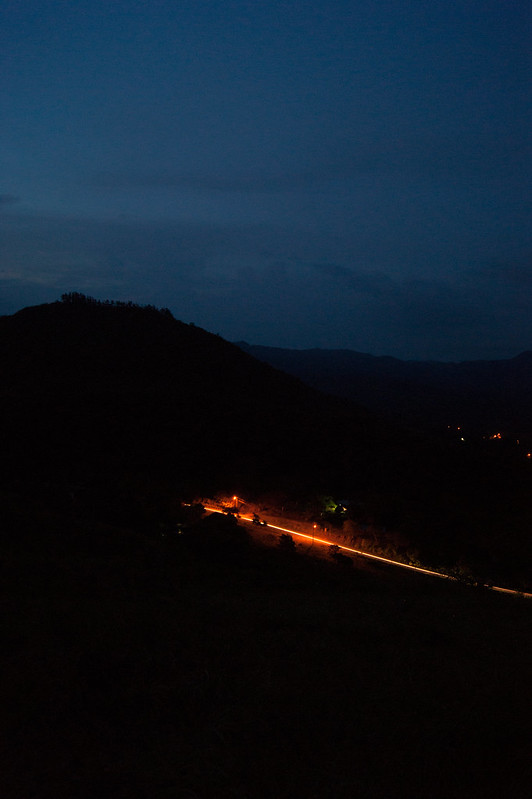|
This is the view just outside of my door. Sadly, my last purchase of camera gear didn't include a tripod. I'll have to wait a few more months until I can get some interesting foregrounds.
huhu fucked around with this message at 18:08 on Jul 29, 2014 |
|
|
|

|
| # ¿ May 16, 2024 23:36 |
|
Ok, so this question is really dumb, and I'm pretty sure I know the answer, but I'm hoping someone could clarify this for me a bit. Do longer exposures, in any way reduce the amount of light in the shot? I'm watching a video of a guy taking a nighttime shot of some rocks with a small brick building in the background. He paints the rocks with this massive flashlight, nick named "The Sun" or something. The shot comes out looking pretty decent but I'm thinking if you're shining "the sun" at a rock it should show up as white on the camera. As a note, he shot at ISO100 for 18 minutes.
|
|
|
|
xzzy posted:In short, yes. Given: Situation A: ISO100, f/22, 18 minutes Situation B: ISO100, f/22, 30 seconds If you have a quantity of light X, will both situations register it as X or would A register it at (fake values I just made up) X and then B register it at .23*X. (So that 23% less light gets in) Less technical, if you took situations A and B, illuminated a large rock for 5s in each shot, would that rock look exactly the same in both shots?
|
|
|
|
I finally got a remote for my camera but it's the rainy season now and the next cloudless night will probably be in January. : suicide:
|
|
|
|
 Panama 078 by esa_foto, on Flickr Panama 078 by esa_foto, on Flickr
|
|
|
|
 Panama 080 by esa_foto, on Flickr
|
|
|
|
 7-365 Stars and Palm Trees (Cocle, Panama) by esa_foto, on Flickr
|
|
|
|
 Safe in the Harbor (Ometepe Island, Nicaragua) by Esa Foto, on Flickr Safe in the Harbor (Ometepe Island, Nicaragua) by Esa Foto, on Flickr
|
|
|
|
Star Trails from the ISS: http://www.forbes.com/sites/startswithabang/2016/04/04/what-do-star-trails-look-like-from-the-iss/#543ff3db47eb
|
|
|
|
CommanderApaul posted:Does 10 seconds count as long exposure? What ISO/aperture did you shoot this at? It's quite blurry. Also, did you use a tripod or just leave it on a flat surface?
|
|
|
|
CommanderApaul posted:I had it on a gorillapod on the steps of the Lincoln Memorial. I used Lightrooms built-in presets and it kinda blew everything out, I was exhausted when I got back to the hotel last night. I'm going through some of them with Nik tools now and that's working much better. With such a far subject distance, you should be able to shoot wide open and still get a solid depth of field. If you're curious you can check out the DOF calculator here: http://www.dofmaster.com/dofjs.html Use your 2s self-timer because taking a picture causes the camera to shake a slight bit. Try to lower your ISO and take use longer shutter speeds. Turn off image stabilization since you're using a tripod.
|
|
|
|
CommanderApaul posted:Yeah, I was hoping I just didn't suck but in the end, there it is. For the future, practice on random crap so that when you're actually in a cool place you'll be ready. Star photos - practice from your backyard, sports - practice with your animals/kids running around, panning - practice on cars, etc.
|
|
|
|
For those that are unaware. https://www.washingtonpost.com/news...s-how-to-watch/
|
|
|
|
jackpot posted:It might deserve a new thread, but I don't have time to do it - who's checking out tonight's meteor shower? From everything I'm reading it should be a hell of a show. I'm charging up my gear now. Just bought myself a 6 pack as well.
|
|
|
|
I used spray and pray, got some garbage pictures of clouds and a half decent shot. I miss living in the middle of nowhere Panama if only for the star photography.  DSC08657 by Esa Foto, on Flickr DSC08657 by Esa Foto, on Flickr
|
|
|
|
This was pretty cool though. https://www.youtube.com/watch?v=xGdm4JEb3iY
|
|
|
|
I did 5s, f1.8, ISO 1600. What's your max aperture?
|
|
|
|
How about you guys post some of the pictures you shot? I took this:  Palm Tree and Stars (Cocle, Panama) by Esa Foto, on Flickr Palm Tree and Stars (Cocle, Panama) by Esa Foto, on Flickrwith a garbage camera that didn't really function past 800ISO. This shot was F1.8, 16s, ISO1600 and I didn't even have a tripod, just set my camera flat on the ground and pointed it straight up.
|
|
|
|
 IMG-20170103-WA0001 by Esa Foto, on Flickr IMG-20170103-WA0001 by Esa Foto, on Flickr
|
|
|
|

|
| # ¿ May 16, 2024 23:36 |
|
 DSC_8664 DSC_8664
|
|
|







